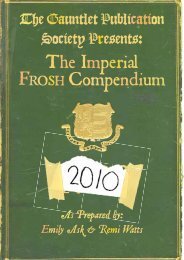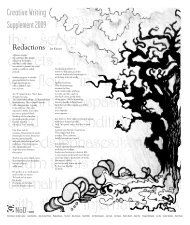PDF Edition - The Gauntlet
PDF Edition - The Gauntlet
PDF Edition - The Gauntlet
You also want an ePaper? Increase the reach of your titles
YUMPU automatically turns print PDFs into web optimized ePapers that Google loves.
GAUNTLET NEWS SEPTEMBER 13.07 7<br />
Students examine the oil sands<br />
Andrew Barbero<br />
<strong>Gauntlet</strong> News<br />
One University of Calgary<br />
class aims to keep Alberta<br />
green, both environmentally<br />
and fi nancially.<br />
Th e university’s environmental<br />
science department sent 22 students<br />
on a fi eld school experience<br />
to study the oil sands and other<br />
potentially at-risk industrial environments<br />
throughout northern and<br />
southern Alberta. Th ese excursions,<br />
which occurred two weeks prior to<br />
the beginning of the fall semester,<br />
gave students an up-close look at<br />
the impacts and nuances of Alberta’s<br />
economic engine.<br />
“We had a vague sense of what to<br />
expect,” said environmental studies<br />
student Danny Chavez. “But the<br />
sheer scale of the operation was quite<br />
shocking.”<br />
Unlike traditional petroleum,<br />
the oil sand deposits around the<br />
Athabasca River in northern<br />
Alberta consist of a mixture of oil,<br />
sand, minerals and water. Extracting<br />
the oil from that mixture requires<br />
a great deal of eff ort, resource and<br />
expense; and only today’s high<br />
crude prices make the endeavor<br />
economically feasible. However, a<br />
signifi cant environmental footprint<br />
is left behind.<br />
“Th e oil sands have a tremendous<br />
environmental impact,” said Sierra<br />
Club prairie chapter director Lindsey<br />
Telfer. “Current estimates say four<br />
barrels of water are needed to extract<br />
one barrel of oil and water used in the<br />
oil sands can’t be used for anything<br />
else. So, up north, we’re beginning<br />
to see dam after dam filled with<br />
toxic water.”<br />
Telfer warned the environmental<br />
impact is not contained within<br />
Alberta.<br />
“Th e oil sands are located in the<br />
heart of Canada’s boreal forest,”<br />
explained Telfer. “It can’t just be<br />
put back by the reclamation process.<br />
We are starting to see acid<br />
rain in Manitoba and Saskatchewan.<br />
Th ere is an increase in air pollutants<br />
and greenhouse gases. We need<br />
to take time to identify the limits of<br />
Chavez takes a look at an oil sands sample.<br />
oil sands sustainability.”<br />
However, the visiting environmental<br />
science class observed some<br />
positive changes.<br />
“Alberta Environment is very cautious<br />
when it comes to things like<br />
water,” said Chavez. “Each mine is<br />
allotted so much and they track it<br />
very carefully. Overall, oil companies<br />
have a lot invested in these projects<br />
so they don’t want to screw up. Th ey<br />
are concerned about their environmental<br />
impact.”<br />
Th e provincial government does<br />
not require oil companies to leave<br />
mined sites in original condition, but<br />
instead in a vague state of equivalent<br />
land capability.<br />
“[Oil companies] undertake signifi<br />
cant eff orts to reclaim the land,”<br />
said U of C chemistry professor and<br />
course instructor Jürgen Gailer.<br />
“When you take out as much as 30<br />
metres of soil, the landscape will not<br />
look identical, but from a productivity<br />
standpoint, the environment<br />
functions in much the same way it<br />
should.”<br />
For their part, oil companies realize<br />
how important sustainability is<br />
to their bottom line.<br />
“Th e oil sands are a legacy resource<br />
for Albertans,” said Suncor Energy’s<br />
spokesman Brad Bellows.<br />
Suncor pioneered oil sands exploration<br />
and will celebrate their 40th<br />
anniversary of oil sands exploration<br />
this month.<br />
“Th ere is a variety of social and<br />
environmental challenges associated<br />
with oil sands exploration, but we<br />
have a history of overcoming challenges,”<br />
said Bellows. “We have<br />
reduced our water use, cutting it in<br />
half, but there is a still of lot of work<br />
to be done.”<br />
In a report on climate change<br />
released earlier this month by<br />
Suncor, the company claimed to<br />
have reduced greenhouse gas emissions<br />
by 26 per cent since 1990, as<br />
well as investing approximately<br />
$250 million in renewable energy<br />
initiatives.<br />
“It is a billion-dollar industry producing<br />
a million barrels of oil per<br />
day,” explained Bellows. “We have<br />
suffi cient resources at this point to<br />
Daniel Pagen/the <strong>Gauntlet</strong><br />
continue for another 100 years.<br />
But we defi nitely have to look at<br />
water resources; they’re critical for<br />
the province and the industry.”<br />
But for environmentalists like<br />
Telfer, some responsibilities don’t<br />
fall under corporate jurisdictions.<br />
“Oil companies have fiduciary<br />
responsibilities, but it’s the<br />
government’s responsibility to set<br />
terms for industrial development<br />
in the region, and the government<br />
has failed to do that,” said Telfer.<br />
Telfer explained the government<br />
could change its ways if the voters<br />
made the oil sands an issue.<br />
“We are coming upon a very busy<br />
election year municipally, provincially<br />
and federally,” she said. “It’s an<br />
opportune time to have these discussions<br />
with our representatives.”

















